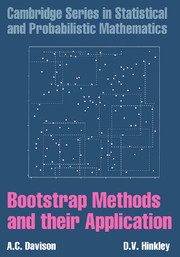Book contents
- Frontmatter
- Contents
- Preface
- 1 Introduction
- 2 The Basic Bootstraps
- 3 Further Ideas
- 4 Tests
- 5 Confidence Intervals
- 6 Linear Regression
- 7 Further Topics in Regression
- 8 Complex Dependence
- 9 Improved Calculation
- 10 Semiparametric Likelihood Inference
- 11 Computer Implementation
- Appendix A Cumulant Calculations
- Bibliography
- Name Index
- Example index
- Subject index
11 - Computer Implementation
Published online by Cambridge University Press: 05 June 2013
- Frontmatter
- Contents
- Preface
- 1 Introduction
- 2 The Basic Bootstraps
- 3 Further Ideas
- 4 Tests
- 5 Confidence Intervals
- 6 Linear Regression
- 7 Further Topics in Regression
- 8 Complex Dependence
- 9 Improved Calculation
- 10 Semiparametric Likelihood Inference
- 11 Computer Implementation
- Appendix A Cumulant Calculations
- Bibliography
- Name Index
- Example index
- Subject index
Summary
Introduction
The key requirements for computer implementation of resampling methods are a flexible programming language with a suite of reliable quasi-random number generators, a wide range of built-in statistical procedures to bootstrap, and a reasonably fast processor. In this chapter we outline how to use one implementation, using the current (May 1997) commercial version Splus 3.3 of the statistical language S, although the methods could be realized in a number of other statistical computing environments.
The remainder of this section outlines the installation of the library, and gives a quick summary of features of Splus essential to our purpose. Each subsequent section describes aspects of the library needed for the material in the corresponding chapter: Section 11.2 corresponds to Chapter 2, Section 11.3 to Chapter 3, and so forth. These sections take the form of a tutorial on the use of the library functions. The outline given here is not intended to replace the help files distributed with the library, which can be viewed by typing help (boot, library = “boot”) within Splus. At various points below, you will need to consult these files for more details on functions.
The main functions in the library are summarized in Table 11.1.
The best way to learn to use software is to use it, and from Section 11.1.2 onwards, we assume that you, dear reader, know the basics of S, including how to write simple functions, that you are seated comfortably at your favourite computer with Splus launched and a graphics window open, and that you are working through this chapter.
- Type
- Chapter
- Information
- Bootstrap Methods and their Application , pp. 522 - 550Publisher: Cambridge University PressPrint publication year: 1997

